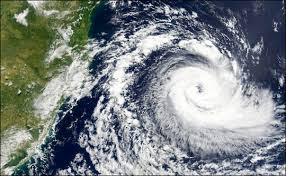Tropical cyclons
A tropical cyclone is a rapidly rotating storm, caused: in a big amount of water (ocean), by winds moving near the ocean at diferent directions and the ocean at minimun of 27° C.
Depending on its location and strength, a tropical cyclone is referred to by different names. They are:
• Hurricanes: are composed over the North Atlantic Ocean and Northeast Pacific
• Typhoons: are composed over the Northwest Pacific Ocean
• Cyclones: are composed over the South Pacific and Indian Ocean
Firstly, storms were given random names. But then, meteorologists decided to introduce a more organised and efficient system, taking names instead from a list arranged alphabetically. The original list had only women's names until 1979, when men's names were introduced. Actually, they alternate each year. Six lists are used in rotation, so the list for 2016 will be used again in 2022.
Tropical cyclones are formed when warm and wet air rises, creating a low pressure zone. Ascending warm air causes the pressure to low at higher altitudes. Warm air is under a higher pressure than cold air, so it moves upper. So the low pressure ‘sucks in’ air from the warm surroundings, which then also rises. A continuous movement of warm and wet air continues to create clouds and rain. Air that surrounds the low pressure zone at the centre flows in a spiral at very high speeds. Air is banished at the top of the storm and falls to the outside. As this happens, it reduces the mass of air over the ‘eye of the storm’, causing the wind speed to increase further. Some ejected air also cools and dries, and sinks through the eye of the storm, adding to the low pressure at the centre. The faster the winds blow, the lower the air pressure in the centre, and so the cycle continues. It grows stronger and stronger. As hurricanes move inshore, their power gradually reduces because their energy comes from sucking up moist sea air.
There is a scale that measures the intensity of a cyclone, that goes from 1 to 5; number 5 is the most severe one. For example, a cyclone 1 presents negligible house damage; damage to some crops, trees and caravans; craft may drag moorings. On the other side, cyclone 5 presents something extremely dangerous with widespread destruction.
Much people are affected by tropical cyclones, firstly they can hurt you, or even kill you. Moreover, after it, depending on the intensity, houses are destroyed, crops, even entire villages. Also, the water that stays stagnant, can cause the spread of a disease and floodings. This is why it’s very important to know how to act in this situations. Your house has to be prepared; the roof shouldn’t be broken or weak, windows need to have kind of big woods and floods should be prevented. Having clean wáter and food is fundamental. Moreover you always should have a radio and a complete survival kit.
Depending on its location and strength, a tropical cyclone is referred to by different names. They are:
• Hurricanes: are composed over the North Atlantic Ocean and Northeast Pacific
• Typhoons: are composed over the Northwest Pacific Ocean
• Cyclones: are composed over the South Pacific and Indian Ocean
Firstly, storms were given random names. But then, meteorologists decided to introduce a more organised and efficient system, taking names instead from a list arranged alphabetically. The original list had only women's names until 1979, when men's names were introduced. Actually, they alternate each year. Six lists are used in rotation, so the list for 2016 will be used again in 2022.
Tropical cyclones are formed when warm and wet air rises, creating a low pressure zone. Ascending warm air causes the pressure to low at higher altitudes. Warm air is under a higher pressure than cold air, so it moves upper. So the low pressure ‘sucks in’ air from the warm surroundings, which then also rises. A continuous movement of warm and wet air continues to create clouds and rain. Air that surrounds the low pressure zone at the centre flows in a spiral at very high speeds. Air is banished at the top of the storm and falls to the outside. As this happens, it reduces the mass of air over the ‘eye of the storm’, causing the wind speed to increase further. Some ejected air also cools and dries, and sinks through the eye of the storm, adding to the low pressure at the centre. The faster the winds blow, the lower the air pressure in the centre, and so the cycle continues. It grows stronger and stronger. As hurricanes move inshore, their power gradually reduces because their energy comes from sucking up moist sea air.
There is a scale that measures the intensity of a cyclone, that goes from 1 to 5; number 5 is the most severe one. For example, a cyclone 1 presents negligible house damage; damage to some crops, trees and caravans; craft may drag moorings. On the other side, cyclone 5 presents something extremely dangerous with widespread destruction.
Much people are affected by tropical cyclones, firstly they can hurt you, or even kill you. Moreover, after it, depending on the intensity, houses are destroyed, crops, even entire villages. Also, the water that stays stagnant, can cause the spread of a disease and floodings. This is why it’s very important to know how to act in this situations. Your house has to be prepared; the roof shouldn’t be broken or weak, windows need to have kind of big woods and floods should be prevented. Having clean wáter and food is fundamental. Moreover you always should have a radio and a complete survival kit.


Nice job, Luna. Check that we don't say that"Typhoons are composed over the..." It's better if you use the phrase "Typhoons occur over..."
ResponderEliminar